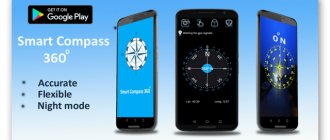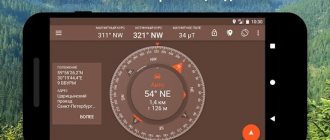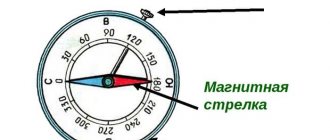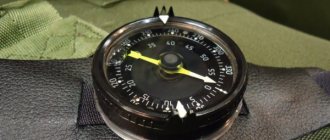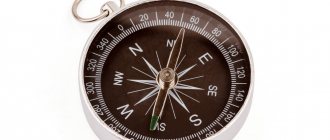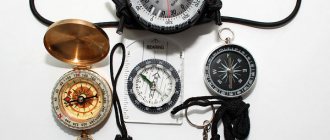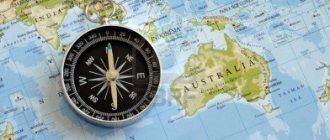The compass is considered one of the most ancient devices that helped people navigate the terrain. The history of its creation is studied at school. But if you try to find the very first mentions of a magnetic compass, you can only come across fragments of stories from which it is difficult to understand who exactly became the creator of this invention.
India, Greece and China are competing for the title of being the first country where a compass appeared. In each of them, ancient records were found about the use of this device, but it is very difficult to determine its exact time of appearance in each of the states. Scientists also do not exclude the possibility that they are mistaken, so they are constantly searching for any information in the rest of the world.
Magnetic compass
In everyday life, people almost never use a magnetic compass, but for sailors and travelers it is an indispensable thing that can save a life if a person gets lost and does not remember the way home. Ordinary compasses consist of a plastic box (or a round brass box) and a needle. Usually it is made of steel. In the center there is a small piece of stone - agate. It is necessary to reduce friction between the arrow and the tip of the spire.
History of creation
Some historians are sure that the man who invented the compass lived in China. It is believed that it was originally planned to be used only on land, and was not suitable for sea travel. But in those days the device was not much like a modern compass. It looked more like a spoon lying on a polished slab. The handle of this spoon was made of magnetite. It rotated freely, and there was only one arrow and it pointed only to the south.
In the 6th century AD, the compass changed and became similar to the modern one, with a rotating arrow. Soon the invention reached the Arab countries. Local sailors really liked it, so they began to use it very often to find the right path on a long sea voyage.
Note! 200 years later, a similar device appeared in the European part of the world. Around the same time, the compass was improved, which virtually eliminates the possibility of getting lost. The magnetic needle was secured with a pin to the bottom of the compass bowl or its paper base.
Soon the device fell into the hands of the Italian Flavio Gioia. He studied a brief history of the compass and improved it by installing a round coil with sixteen diamonds. Later there were 2 times more divisions. In the 18th century, the compass began to look like a complex device, designed not only to indicate the cardinal directions, but also to show the time.
On what principle do compasses work?
The compass is able to determine the cardinal directions due to the interaction of its two magnets and magnetic poles. The device is equipped with a freely rotating pointer. One end of it constantly points to the north pole, and the other to the south.
William Gilbert was the first to suggest that the planet has magnetic poles. He described this phenomenon in his book “On the Magnet.” In his story, Gilbert concludes that our planet is a huge magnet. After some time, researchers discovered magnetic poles (these are areas where the magnetic needle becomes vertical). This discovery was attributed to John Ross (English explorer).
First compass
The history of the compass begins in the 3rd century, when it was described by the Chinese philosopher Han Fei-tzu. By this time, the device was used by sailors to navigate far from the coast.
The first compass was a spoon carved from magnetite ore. The spoon had a special shape and, thanks to the careful processing of the surfaces, rotated freely on a polished copper plate; its handle never touched the plate and pointed south.
Rice. 1. The first Chinese compass.
Icons of the zodiac constellations and designations of the sides of the horizon were applied to the plate.
In the 9th century, the design of the compass changed - a magnetic needle in the shape of a fish moved freely in a vessel with water, the head of the fish pointed to the south. To protect from the wind, the vessel was covered with a glass plate.
Compass of ancient countries
At the moment, scientists cannot say exactly in which ancient country the inventors invented the compass. But they all propose three states for consideration: Greece, China and India. This is partly due to the fact that the invention was invented a very long time ago, so no evidence has survived to this day, after studying which we can draw a final conclusion.
First Chinese compass
Some researchers involved in the history of the invention of the compass believe that the phenomenon of magnetism was first noticed and discovered by the Greeks. But at the same time, we cannot discard another point of view, which gives the authorship of the discovery to the ancient Chinese inventors. Scientists who claim that the Chinese invented the device refer to ancient writings found here. Moreover, based on the same chronicles, magnetite was also discovered in China one thousand years earlier.
The writings also mention that the Chinese ruler Huang Di during the war used a device similar in function to a compass. Another version says that the device resembled a chariot on which a magnetic figurine of a man was installed, pointing to the southern direction. This chariot could be mounted on any ancient vehicle.
It was connected to the wheels in such a way that the gear mechanism located inside the invention rotated in the opposite direction while the cart was turning. This is necessary so that the indicator mounted on the chariot can always show the correct direction, regardless of where the vehicle is moving.
In order for this device to always work correctly, it is very important to set the pointer in the right direction even before the chariot sets off on its first journey, otherwise the little man will point in the wrong direction. As for the first compass in the form of a flat board and a spoon lying on it, it was used by magicians to predict the future, since the movement of the arrow was explained by the influence of otherworldly forces.
The compass was used for rituals only until the 2nd millennium BC. According to other versions, the magnetic properties of the device were used in the 4th millennium BC during Feng Shui rituals. At that time, the phenomenon of magnetism was explained as a magical manifestation of higher powers. Only 100 years later, Chinese sailors began to use the compass for its intended purpose and took it on long sea voyages.
Compass in India
Some researchers believe that the compass first appeared in India, or that local inventors created it around the same time as the Chinese, but without their intervention or prompting. Based on the brief history of the creation of a compass in India, the inventors were prompted to discover it by a mountain located near the Indus River. Over time, local residents began to notice that she was able to inexplicably attract small metal objects to herself.
Soon the magnetic properties of the rock began to be used in Indian medicine. One of the local doctors began to use a magnet during surgical operations. Like the Chinese, the Indians used a compass when going to sea. They decided not to invent anything new and made a magnetized arrow in the shape of a fish. Her head constantly pointed south.
Who invented the first compass?
The most ancient device that makes it easier to navigate the terrain is the compass. Its arrows point to the Earth's magnetic poles. Every schoolchild is familiar with this simple device. Surprisingly, it was invented long before our era.
History of the compass
Presumably, the history of the compass begins in the 3rd century BC. The ancient Chinese were the first to realize the amazing property of magnetite to show the Earth's poles.
To move through the desert, they invented a device that bore little resemblance to a modern compass, but its operating principle was the same. The ancient compass resembled a spoon lying on a polished plate. The handle of this magnetite spoon rotated freely and, when stopping, pointed to the south.
Much later, in the 11th century AD, the Chinese came up with a compass with a floating needle in the shape of a fish. The Arabs really liked this device, and they began to use it to find the right direction on long sea voyages.
In the 13th century. Europeans began to use a similar device. And in the XIV century. The compass acquired a look similar to the modern one. The magnetic needle was secured with a pin at the bottom of the vessel or on a paper base.
The Italian Flavio Joyo improved the device by equipping it with a round card with 16 rhombuses (4 for each cardinal direction). Even later, the circle was divided into 32 parts. By the 18th century The compass was already a complex device that showed not only the direction of movement, but also the time.
What now
Now there are many types of compass:
- electromagnetic,
- electronic,
- gyro-compass.
They are more advanced and are used on ships and aircraft. However, the good old magnetic compass continues to live, being the most convenient and reliable device for geologists, climbers and ordinary travel enthusiasts.
ktoetotakie.ru
Operating principle of an electronic compass
An electromagnetic device is an expanded electric generator, where the magnetic field of the planet acts as a stator, and one frame or more is a rotor. This compass compares favorably with the standard magnetic one in that there is no deviation from the ferrimagnetic parts of the vehicle.
Note! For correct operation of the device with a galvanometer, fast movement is necessary, so in most cases this compass is used in aviation.
Gyroscopic type compass
In short, a gyrocompass is a device that indicates the poles on the surface of the earth and water. The device consists of one or more gyroscopes. It is an integral part of navigation systems on ships. If you compare this compass with a regular magnetic one, it always points to the true North Pole, not the magnetic one.
The device can be used as a navigation device, so it is installed in the steering system on marine vessels. It will also be useful if you need to determine the exact direction when aiming the guns of warships. Speaking of marine gyrocompasses, they are very heavy. The weight of some of them exceeds 25 kilograms.
Interesting Facts
When using a compass, it is always worth remembering that its arrow does not point strictly north. It often deviates because the location of the geographic poles does not coincide with the magnetic ones. When used in aviation, the device is only able to indicate the correct heading if the aircraft is moving in a straight line. When a plane flies, for example, from America to Europe, throughout the rest of the flight the pilots are coordinated by dispatchers using messages.
Modern types of compasses
In the modern world, there are several types of compasses, namely:
- radio compass A device equipped with a direction finder;
- electromagnetic compass. As mentioned above, there is an electric generator installed inside it, which is necessary to drive the magnetic field;
- electronic compass. Indicates the four cardinal directions. It can be found as an application, so even a child can install it on their smartphone or tablet;
- gyro-compass. The most geographically accurate device.
Modern compass
Subsequent improvements did not make significant changes to the device. A patent for a modern version of the compass was received in 1908. From that time on, mass production began.
Today there are several types of compass: a mountain compass for geologists, a gyrocompass for ships and rocketry, and an electronic compass that communicates with satellites.
Using a mountain compass, you can navigate the terrain, measure vertical angles, and determine the elevation of points in the relief.
Rice. 3. Mountain compass.




